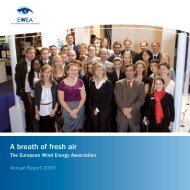Offshore Electricity Infrastructure in Europe - European Wind Energy ...
Offshore Electricity Infrastructure in Europe - European Wind Energy ...
Offshore Electricity Infrastructure in Europe - European Wind Energy ...
Create successful ePaper yourself
Turn your PDF publications into a flip-book with our unique Google optimized e-Paper software.
4. Case-<strong>in</strong>dependent model<br />
Dur<strong>in</strong>g the course of the study it became apparent that<br />
the appropriate w<strong>in</strong>d farm connection design is very<br />
sensitive to the specific cases under <strong>in</strong>vestigation:<br />
distances to shore, w<strong>in</strong>d farm capacities, price profile<br />
differences between the countries, etc. The results of<br />
the specific cases are useful but general conclusions<br />
are necessary for the optimal offshore grid design and<br />
also for clear recommendations, which is one central<br />
goals of the <strong>Offshore</strong>Grid study. A case-<strong>in</strong>dependent<br />
model was therefore developed with <strong>in</strong>puts from the<br />
<strong>in</strong>frastructure model and the power system model. It<br />
allows develop<strong>in</strong>g general offshore grid design rules,<br />
which are then validated with the results of the specific<br />
cases of the model.<br />
In the follow<strong>in</strong>g sections, the key features of each of<br />
the mentioned models are described.<br />
C.I W<strong>in</strong>d power time series<br />
model<br />
S<strong>in</strong>ce on- and offshore w<strong>in</strong>d power production is a crucial<br />
element <strong>in</strong> design<strong>in</strong>g an offshore grid, <strong>Offshore</strong>Grid<br />
builds on high-resolution time series of w<strong>in</strong>d speed<br />
and power output of onshore- and offshore w<strong>in</strong>d farms<br />
which served as <strong>in</strong>put for the modell<strong>in</strong>g power flows<br />
and power markets. For all s<strong>in</strong>gle offshore w<strong>in</strong>d farm<br />
locations of the <strong>in</strong>put scenario, synchronous hourly<br />
time series of historical w<strong>in</strong>d speed were calculated<br />
with a high-resolution weather model. These are then<br />
transformed <strong>in</strong>to w<strong>in</strong>d power production time series by<br />
us<strong>in</strong>g special power curves.<br />
The applied Weather Research and Forecast<strong>in</strong>g Model<br />
WRF [1] is a meso-scale numerical weather prediction<br />
model, able to simulate the atmospheric conditions<br />
across a wide range of horizontal resolutions from<br />
100 km down to 1 km. The data <strong>in</strong>put for WRF is<br />
provided by 6-hourly global weather analysis data 59 .<br />
The WRF-simulations dynamically downscale the<br />
weather analysis data from six-hourly resolution on<br />
a horizontal grid of 1° by 1° to one-hourly data on a<br />
9x9 km² grid 60 .<br />
59 In this case: FNL F<strong>in</strong>al Analysis from the United States’ National Centre for Environmental Prediction (NCEP).<br />
60 In geographical coord<strong>in</strong>ates, 1° corresponds approximately to 50-111 km.<br />
<strong>Offshore</strong>Grid – F<strong>in</strong>al Report<br />
FiGuRe 12.2: GeOGRaphical dOma<strong>in</strong>s FOR the wRFsimulatiOn<br />
as used <strong>in</strong> the OFFshOReGRid pROject<br />
The region of the Northern <strong>Europe</strong>an waters is<br />
modelled with a higher spatial resolution than the<br />
rema<strong>in</strong>der of <strong>Europe</strong> (see Figure 12.2):<br />
• <strong>Europe</strong> north of the Alps: 9 x 9 km² (<strong>in</strong>clud<strong>in</strong>g<br />
offshore regions <strong>in</strong> focus)<br />
• <strong>Europe</strong> south of latitude 48°N: 27 x 27 km²<br />
The w<strong>in</strong>d speed time series were calculated for all<br />
relevant hub heights of turb<strong>in</strong>es <strong>in</strong> today’s and future<br />
offshore and onshore w<strong>in</strong>d farms. Special attention<br />
was paid to the vertical w<strong>in</strong>d speed profiles <strong>in</strong> different<br />
thermal stratifications of the local atmospheric flow,<br />
which were modelled with an improved, so called<br />
MYJ-Scheme for the atmospheric Planetary Boundary<br />
Layer (PBL) [7]. The model output is validated<br />
with real w<strong>in</strong>d speed data at different heights, i.e.<br />
measurements from the German offshore platform<br />
FINO-1 [6]. Previous simulations with similar model<br />
sett<strong>in</strong>gs were also checked with other meteorological<br />
observations, e.g. the met mast Östergarnsholm <strong>in</strong><br />
the Baltic Sea. The model proved to be accurate and<br />
robust.<br />
After the WRF model runs were performed and<br />
validated, the w<strong>in</strong>d speed time series at more than<br />
350 offshore sites and 16,000 onshore grid po<strong>in</strong>ts as<br />
def<strong>in</strong>ed <strong>in</strong> the scenarios and models were determ<strong>in</strong>ed.<br />
119









